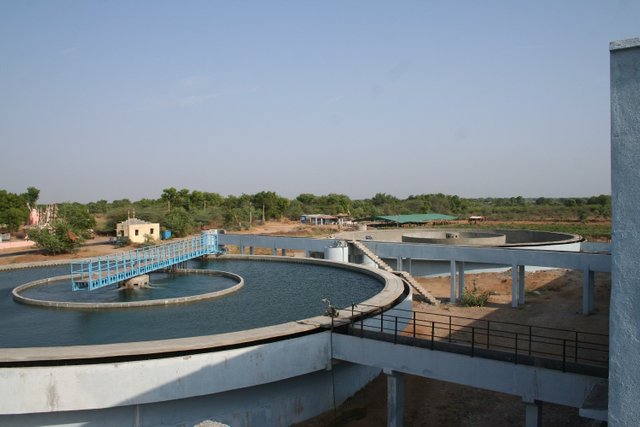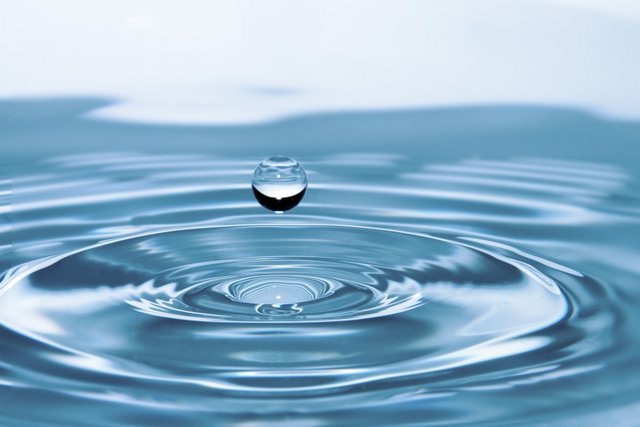WATER
Hello everyone...👋... it’s @essiens, it feels great being a steemian. My last post here was an introductory post... in which I made a brief introduction on myself... so this is gonna be my second post here on steemit, and this second post is gonna be a science post in which I’ll write on the topic WATER.
However, water plays an important role in the human body. The human body is made up of about 60% of water, the brain is 75% water and our blood is 83% of water. We are continually losing water over the day through urine, sweat and in our breath as vapour. This water has to be replaced, as the body cannot store water. In fact, the human body can last for weeks without food but only few days without water; water is absolutely essential to life and it’s one of the most important things needed in the human body.
- DEFINITION OF WATER
Water is the transparent, tasteless, odorless, and nearly colorless chemical substance that is the main constituent of Earth's streams, lakes, and oceans, and the fluids of most living organisms, and that is vital for all known forms of life, even though it provides no calories or organic nutrients.
This definition tells us that water is colorless, tasteless and odorless. So this definition makes us to understand that any liquid substance that has taste, color and odor is not water. So if you should add anything to water(like sugar or salt) or add any color to it, it’s no more water, it’s something else. So water has to be pure.
So Having known what water is, let’s see what are the types of water.
- TYPES OF WATER
However, Water is distinguished on the basis of it’s origin, consistency, composition and treatment.
The types of water are:
 can help you to eat less and is a relatively easy habit to implement if trying to lose weight. A 2015 study for example, found that simply drinking 500ml of water 30 minutes before each meal, helped overweight adults lose an extra 1.3kg in 12 weeks (1). Foods with a high water content will also help keep us feeling full and help appetite control; fruit and vegetables, porridge and soups are especially good for this.
- DETOXIFICATION:
Water is important to remove waste products from the body and to help the body process and get rid of any toxins. The kidneys require plenty of water to filter and remove impurities and waste from the blood. The liver, your body’s main detoxification organ also needs water to neutralise harmful substances so they can be safely removed from the body. Adding a squeeze of lemon to your water will further stimulate the liver’s detoxification pathways.
- SKIN:
Dehydration causes the skin to become dry, and look dull and even makes wrinkles look worse. Staying well hydrated is essential for your skin to stay radiant, to help prevent acne and to generally look and function at its best. Fluid retention also occurs when the body is short on fluids, as it hangs on to the precious water it does have – this can make skin look puffy and can make you feel bloated all over. When we drink plenty of water, it helps the body rid itself of excess sodium and ironically reduces water retention.
- FUNCTIONS OF WATER:
It keeps skin hydrated.
It helps in the regulation of body temperature.
Acts as a delivery system, taking nutrients to cells and removing waste.
It Forms the base of many bodily fluids such as blood and saliva.
Needed for digestion, softening and dissolving food components.
Essential for normal bowel movements and preventing constipation.
- USES OF WATER
People could not live without water. We need it to drink, to cook with and to wash ourselves. In this section you can find out more about the ways we use water in our bodies, and in our homes and at work. You can also learn about saving water.
Boy drinking from water bottleWater in our bodies
Every living plant or animal needs water. The human body is made up of two thirds water and without water we would die.
Did you know?
A person could live for weeks without food but only about one week without water.
Water in our homes
Have you ever thought how lucky you are to be able to turn on a tap and have all the water you need?
A hundred years ago most people had no water supply in their homes. Instead they had to carry water from a tap or well on their street. In many countries today, people still need to fetch water from ponds, streams, rivers or wells.
Seventy years ago, most people only had cold water in their homes and all water for washing or washing clothes had to be heated on an open fire or cooker.
Today we use much more water than seventy years ago because:
water is piped directly into our homes
we wash, shower or take baths more often
we have lots of hot water
washing machines and dishwashers use more water
gardens are watered with hoses or sprinklers
cars are washed
-Water at work
Water is not just used in the home. Businesses also need lots of water for:
-farming
-energy
-recreation
-transportation
-industry
 image source
image source
- PURIFICATION OF WATER:
Water purification is the process of removing undesirable chemicals, biological contaminants, suspended solids and gases from water. The goal is to produce water fit for a specific purpose. Most water is disinfected for human consumption (drinking water), but water purification may also be designed for a variety of other purposes, including fulfilling the requirements of medical, pharmacological, chemical and industrial applications. The methods used include physical processes such as filtration, sedimentation, and distillation; biological processes such as slow sand filters or biologically active carbon; chemical processes such as flocculation and chlorination and the use of electromagnetic radiation such as ultraviolet light.
Purifying water may reduce the concentration of particulate matter including suspended particles, parasites, bacteria, algae, viruses, fungi, as well as reducing the concentration of a range of dissolved and particulate matter.
The following ways to purify your way are:
1 – Boiling
Boiling water is the cheapest and safest method of water purification. Water sources and or channels of distribution may render your water unsafe. For example, parasites and germs are things you may not see by bare eyes, but their effects can be life threatening.
In this method, clean water should be brought to boil and left at rolling-boil for 1-3 minutes. For people living in high altitude areas, it is recommended to boil your water for longer than water boiled at lower altitudes. This is because water boils at lower temperatures in higher altitudes. Boiled water should be covered and left to cool before drinking. For water drawn from wells, leave it for compounds to settle before you filter out clean water for use.
2 – Filtration
Filtration is one of the effective ways of purifying water and when using the right multimedia filters it’s effective in ridding water of the compounds. This method uses chemical and physical processes to purify water and make it safe for human consumption. Filtration eliminates both large compounds and small, dangerous contaminants that cause diseases with a simple and quick filtration process.. Since filtration does not deplete all the mineral salts, water that has been filtered is considered healthier compared to water purified using other methods. It’s one of the effective water purification methods that utilize chemical absorption process that effectively removes unwanted compounds from water.
Compared to reverse osmosis, filtration is considered effective when it comes to selective elimination of much smaller molecular compounds such as chlorine and pesticides. The other factor that makes filtration less costly is that it does not require a lot of energy needed in distillation and reverse osmosis. It is an economic method of water purification because little water is lost during purification.
3 – Distillation
Distillation is a water purification method that utilizes heat to collect pure water in the form of vapor. This method is effective by the scientific fact that water has a lower boiling point than other contaminants and disease-causing elements found in water. Water is subjected to a heat source until it attains its boiling point. It is then left at the boiling point until it vaporizes. This vapor is directed into a condenser to cool. Upon cooling, vapor is reversed into liquid water that is clean and safe for drinking. Other substances that have a higher boiling point are left as sediments in the container.
This method is effective in removing bacteria, germs, salts and other heavy metals such as lead, mercury and arsenic. Distillation is ideal for people who have access to raw, untreated water. This method has both advantages and disadvantages. A notable disadvantage is that it is a slow process of water purification. In addition, it requires a heat source for the purification to work. Although cheap sources of energy are being developed, distillation remains a costly process of purifying water. It is only ideal (effective and least costly) when purifying small quantities of water (It is not ideal for large scale, commercial or industrial purification).
4 – Chlorination
Chlorine is a powerful chemical that has been in use for many years to treat water for home consumption. Chlorine is an effective water purification method that kills germs, parasites and other disease-causing organisms found in ground or tap water. Water can be purified using chlorine tablets or liquid chlorine. As an off-the-shelf water purification product, chlorine is cheap and effective. However, caution should be taken when using chlorine liquid or tablets to treat drinking water. For example, people suffering from thyroid problems should talk to a medical practitioner before using this product. When using chlorine tablets, it is important to apply them in heated water, as they dissolve well in water that is at 21 degree Celsius or higher. Chlorine tablets kill all bacteria leaving your water clean and safe.
CONCLUSION:
So in conclusion, I think in the article, we know what water is all about, it’s importance and it’s purification...
Note this: Water is the most important thing needed in your body, so take it important.
Thanks for reading!!!
References:
importance of water in the body
Definition of water
Types of water
uses of water
water purification
ways to purify water

Great post @essiens welcome to the Steemit Family explore post and enjoy thanks @garrettwallace
Thanks
Hello @essiens, welcome to steemstem and stemng. We are happy to have you here. There are rules which we follow here to make sure that everything works out just fine.
Even though you listed these websites in your reference https://www.mybeautyandgo.co.uk/the-importance-of-water-in-the-body/ and https://food.ndtv.com/food-drinks/types-of-water-7-different-types-of-waters-and-their-purposes-1770281, we found out that you copied a lot of contents from there. Other sites that we found similar materials as your article include https://www.babble.com/best-recipes/water-101-the-7-types-of-water/ and https://www.healthline.com/nutrition/carbonated-water-good-or-bad.
Plagiarism is one of the don'ts in the steemit community as well as heavily frowned upon in steemstem and stemng (a sub-community of steemstem). We would like to recommend that you join the steemstem chat on discord server here: https://discord.gg/axMdmJS and the stemng discord server here: https://discord.gg/sareQ5N and hopefully get a mentor that will guide you.
Thanks so much
Congratulations @essiens! You have completed the following achievement on the Steem blockchain and have been rewarded with new badge(s) :
Click on the badge to view your Board of Honor.
If you no longer want to receive notifications, reply to this comment with the word
STOP